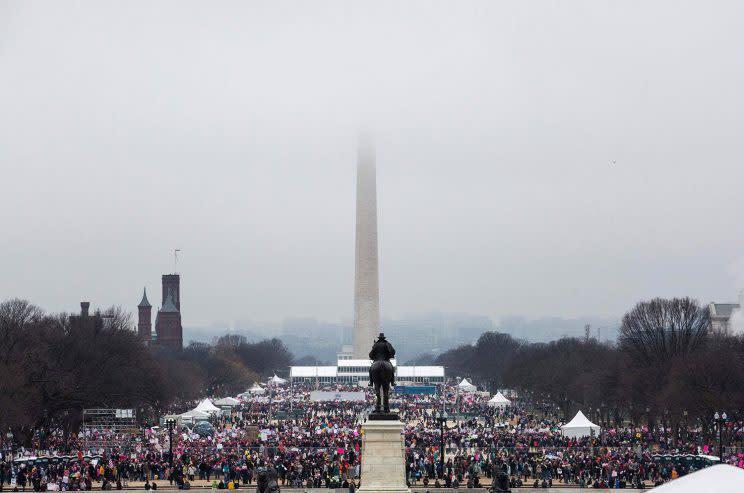More than 1 in 100 Americans marched against Donald Trump Saturday, say political scientists
A professor of political science in Connecticut has aggregated the data from public reports of crowd sizes at the women’s marches across America on Saturday and reached an astonishing conclusion: More than 1 in every 100 people in the U.S. turned out to march against Donald Trump and for women’s rights on the second day of his presidency.
Drawing on reports of 526 different marches in towns as disparate as Wichita Falls, Texas — reported turnout: 150 people — and Washington, D.C. — reported turnout: more than 500,000 — University of Connecticut professor Jeremy Pressman, working with international relations professor Erica Chenoweth from the University of Denver, estimated that 3,341,823 to 4,611,782 people turned out to march across the nation.
The Census Bureau estimated that the U.S. population as of mid-2016 was 323,127,513.
“The overall number is bigger than I expected,” Pressman told Yahoo News about his findings on the protest crowds. “With a low estimate it’s a little bit above 1 percent, and with a higher estimate, it’s probably closer to 1 1/2 percent.”
The Associated Press had reported late Saturday that “more than 1 million people rallied at women’s marches in the nation’s capital and cities around the world.”
On Sunday it became clear the global number had to be higher than that, as the low-end estimates from just four major American cities pushed the total marcher count to nearly 1 million.
In Washington, organizers released a crowd estimate of more than 500,000 early on Saturday morning that was confirmed by city officials on Sunday, and the local Metro authority told the New York Times Sunday that it had logged more than 1 million individual entries into the underground rail system over the course of the day — the second-highest number ever, after Barack Obama’s 2009 inauguration day, which saw 1.12 million entries. Independent crowd scientists studied pictures from the scene for the Times and concluded turnout was at least 470,000 at 2 p.m. Saturday, or three times as many as had attended Trump’s inauguration the day before.

In California, the Los Angeles Times reported that city police estimated “well past” 100,000 people turned out to protest in the state’s most populous city, while protest organizers put the number at 750,000. (Pressman and Chenowith are putting the lower bound at 200,000.) Another 250,000 people rallied in Chicago, according to local march organizers, and the New York City mayor’s office estimated that 400,000 turned out to chant against the president in Trump’s hometown.
Pressman and Chenoweth have been publicly sharing a Google spreadsheet they’ve been using to collect reports on the turnout for hundreds of other women’s marches in America and around the world. Pressman starting to collect figures Saturday morning after posting a query on Twitter asking, “Is there an excel spreadsheet totaling all the marchers in different cities today?”
There wasn’t, so he started one.
People started tweeting at him with links to news reports on their smaller local marches, as well as emailing pictures and firsthand reports. Chenoweth added many estimates being shared from smaller marches on Facebook, where in some cases the crowds were so small they could be counted one by one.
“We’ve listed several hundred protests and marches across the country. I’ve been really struck by that. Some of them are small,” said Pressman about the extent what of organizers called “sister marches.” The main march was in D.C.
Women’s March organizers logged reports of 678 sister marches around the world, with an estimated total of 4,814,000 marchers worldwide.
The professors also have gathered reports of marches where the only source for the number of marchers was a direct report from the marchers themselves, with no public-record documentation to back that up. They have listed those cities but not listed or counted them when adding up their numbers, leaving those cities with a blank cell in their spreadsheet. “We’re being more conservative with the numbers than with the locations,” explained Pressman.
The document, for now, is a work in progress, with the final tally likely to fluctuate as more cities receive formal crowd size estimates, which can sometimes take a few days to be ascertained.
Read more from Yahoo News:
_____
Related slideshows:
Slideshow: Women’s March on Washington D.C. >>>
Slideshow: Women’s March around the world >>>
Slideshow: How newspapers covered President’s Trump inauguration >>>
Slideshow: Anti-Trump inauguration protests break out in U.S. >>>
Slideshow: Protests worldwide against the inauguration of Donald Trump >>>
Slideshow: Obama’s Washington >>>
Slideshow: Donald Trump’s Inauguration Day >>>
Slideshow: 66 hands on 66 Bibles >>>
_____



